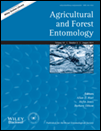Ver ítem
- xmlui.general.dspace_homeCentros e Institutos de InvestigaciónCICVyA. Centro de Investigación en Ciencias Veterinarias y AgronómicasInstituto de Microbiología y Zoología AgrícolaArtículos científicosxmlui.ArtifactBrowser.ItemViewer.trail
- Inicio
- Centros e Institutos de Investigación
- CICVyA. Centro de Investigación en Ciencias Veterinarias y Agronómicas
- Instituto de Microbiología y Zoología Agrícola
- Artículos científicos
- Ver ítem
Acceptability and suitability of Tuta absoluta eggs from irradiated parents to parasitism by Trichogramma nerudai and Trichogramma pretiosum (Hymenoptera: Trichogrammatidae)
Resumen
Tuta absoluta (Meyrick) (Lepidoptera: Gelechiidae) is one of the most devastatingpests of tomato crops. We studied the acceptability and suitability of eggs laid byirradiated T. absoluta pairs to parasitism by the parasitoids Trichogramma nerudaiand Trichogramma pretiosum.2 Trichogramma absoluta pupae were irradiated with X-radiation (20834 R) and theemerged adults were separated into couples according to the crosses: ♂U× ♀U,♂I× ♀U, ♂U× ♀I(where ‘U’ is
[ver mas...]
Tuta absoluta (Meyrick) (Lepidoptera: Gelechiidae) is one of the most devastatingpests of tomato crops. We studied the acceptability and suitability of eggs laid byirradiated T. absoluta pairs to parasitism by the parasitoids Trichogramma nerudaiand Trichogramma pretiosum.2 Trichogramma absoluta pupae were irradiated with X-radiation (20834 R) and theemerged adults were separated into couples according to the crosses: ♂U× ♀U,♂I× ♀U, ♂U× ♀I(where ‘U’ is untreated and ‘I’ is irradiated). In a no-choiceexperiment, 40 eggs from each cross were exposed to a female parasitoid for 24 h.3AllT. absoluta eggs were accepted for oviposition by T. nerudai and were suitablefor its development. However, eggs from irradiated females were signicantly lessparasitized than those from untreated females. Trichogramma pretiosum showed lowparasitism on eggs from all crosses. In a choice experiment, both T. nerudai andT. pretiosum showed no differences in the parasitism of eggs from irradiated (n = 40)and non-irradiated female moths (n = 40).4 These results indicate that eggs laid by irradiated parents were acceptable foroviposition and suitable for the development of these parasitoids, and also supportthe idea that the inherited sterility technique could be used in an integrated approachwith egg parasitoids to control T. absoluta.
[Cerrar]

Autor
Cagnotti, Cynthia Lorena;
Hernandez, Carmen Marcela;
Andorno, Andrea Veronica;
Viscarret, Mariana Mabel;
Riquelme Virgala, María Begoña;
Botto, Eduardo Norberto;
Lopez, Silvia Noemi;
Fuente
Agricultural and forest entomology 18 (3) : 198–205. (2016)
Fecha
2016
ISSN
1461-9563
Formato
pdf
Tipo de documento
article
Palabras Claves
Derechos de acceso
Restringido
 Excepto donde se diga explicitamente, este item se publica bajo la siguiente descripción: Creative Commons Attribution-NonCommercial-ShareAlike 2.5 Unported (CC BY-NC-SA 2.5)
Excepto donde se diga explicitamente, este item se publica bajo la siguiente descripción: Creative Commons Attribution-NonCommercial-ShareAlike 2.5 Unported (CC BY-NC-SA 2.5)

